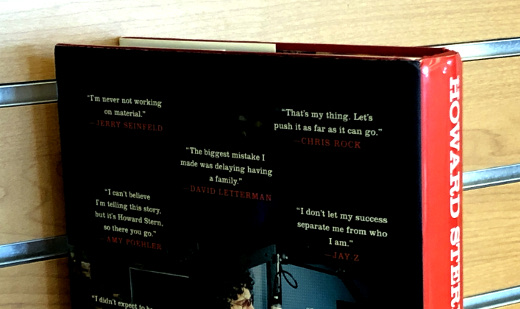What I Learned This Week For March 27 2020

If a day goes by where you don’t learn something new, what good is it really? Sometimes that new nugget of knowledge is welcomed and cherished, and sometimes it is scary as all hell and you wished you didn’t know it. Nonetheless, learning is what we do on this journey of life, whether we like it or not.
I opened a post titled What I Learned This Week So Far This Year For January 10 2014 with the same paragraph above, where I chronicled on a Friday what I learned over the past week. I have thought about doing this again for a while, and with my renewed interest in writing, I restart sharing what I learned below. And don’t worry, it won’t be filled solely with things I learned as a result of being at home under lockdown due to the Coronavirus pandemic!
So here goes:
- When something says it can be installed in “minutes,” it usually doesn’t say how many, or how many hours which also consist of minutes.
- There’s plenty of ground pork in supermarkets these days, ground beef and ground turkey not so much. I heard about this on the No Agenda podcast, and found it to be the case myself for now locally in Northeast Wisconsin.
- Virtual karate lessons can actually work.
- There are Microsoft Office mobile apps, at least for the iPhone. Where I don’t think I would want to use them for creating a document or spreadsheet, they work well for searching a document on the go as well as printing one right from your smartphone.
- A colleague Raj taught me a trick for inserting common phrases you use in an email using Microsoft Outlook and its autocorrect feature. For example, he will type “please#” (without the quotes) and it will insert a sentence “Please let me know if I can be of further assistance.” I had never heard of this hack, and am setting these up as there’s many phrases or sentences I manually type over and over.
- Just when I thought voting in Wisconsin couldn’t get any easier (you can register to vote on election day at your polling place), you can now request an absentee ballot online. In order to do so, you must upload a copy of your driver’s license or state ID, which I have found many people don’t know how to do that when I tell them about it. I do and I did, and got my ballot a few days later.
- My friend Eric wanted to contribute something positive to the fears many have over the coronavirus pandemic, so he hosted a Webinar with friends of his who are a police officer, EMT and nurse. He recorded it and you can watch the webinar here.
- Beginning this year, some Web browsers will limit the length of a registration of a Web site SSL certificate to 1 year. If you have a Web site and don’t know what this means, ask whomever created or manages it.
Maybe you learned something new yourself? Please share your thoughts in the comments of this post.
This is from The Hot Iron, a journal on business and technology by Mike Maddaloni.
Did you enjoy this? Subscribe to The Hot Iron by RSS/XML feed or Read by Email
What I Learned • (1) Comments • PermalinkMy Takeaways From The Silence Of The Wave
When I sat down to write what you are reading now, I wasn’t exactly sure how to start it. I always try to write a clever opener, and after reading The Silence of the Wave by Gianrico Carofiglio, I thought that opener would have come a little more easily. Most of the books I read are business-related or guides of some sort, and I don’t read a lot of novels. Is this why I struggled with this?
As I write takeaways because I feel I am not the reviewer-type, I certainly had takeaways from this novel. It is a story of a former police officer in Rome, Roberto Marias, who treks across the Italian city each week to meet with his psychotherapist. Over the course of his visits he meets another patient of the doctor and a young boy, and the complexities of their lives become intertwined in his own, leading to a great plot twist at the end.
My takeaways are from the story and the book itself.
A translated novel can be engaging – Despite my 100% Italian-American heritage, I never learned Italian. It’s times like this, reading a novel translated from Italian to English, where I wish I could read and speak the language, so I could compare The Silence of the Wave in each language. That being said, the story was still compelling and enjoyable. I never read a translated work before, and I am inclined to do so again.
People need second chances – For reasons I won’t get into here to not spoil the plot, Roberto is no longer a police officer. Though he is not employed in his former career, he still thinks and acts like an officer of the law. Where he may not execute his former job completely going forward, there is no reason why he can’t be in a role where he can use his skills.
I need to read more novels – In a past takeaway I said this, but it has been a while since I have immersed myself in a long-form story, with the closest being issues of the literary magazine december I subscribe to. Even though I was stuck on the opening of this post, reading this story helped free my mind of how it usually processes thoughts.
The author Carofiglio has written other novels as well as a series of crime novels, and I am inclined to read others of his after reading The Silence of the Wave. Special thanks to Nick who sent me this book; I saw him post a write-up of it online, and when I asked him about the book, he dropped in the mail to me. Grazie Mille! As for who I will pass this along to, it is going to my Mother-in-Law, whom I hope enjoys it as much as I did.
This is from The Hot Iron, a journal on business and technology by Mike Maddaloni.
Did you enjoy this? Subscribe to The Hot Iron by RSS/XML feed or Read by Email
Book Take-Aways • (0) Comments • Permalink5 Tips For Those New To Work From Home Due To Coronavirus
 Chances are you are reading this from the comfort of your home. With the declaration of Novel Coronavirus or COVID-19 as a pandemic and declarations of emergencies around the globe, many people are working from home for the near-term. For a lot of them, it is the first time they are working from home for a continuous period of time.
Chances are you are reading this from the comfort of your home. With the declaration of Novel Coronavirus or COVID-19 as a pandemic and declarations of emergencies around the globe, many people are working from home for the near-term. For a lot of them, it is the first time they are working from home for a continuous period of time.
Where working from home isn’t a new concept, not everybody does it. Some companies still don’t have work from home policies. For some industries such as manufacturing, working from home isn’t exactly an option. Even for those people whose employers allow working from home, they may do it once or twice a week, but not every day.
If you are new to this – welcome! I have been working from home continuously for almost the last 3 years and have had a home-based office in the past, so on this topic I have some standing.
Where there is all kinds of advice I can give on working from home for extended periods, I offer these 5 tips to help level-set your experience.
Take a shower – This tip is not as much about your hygiene as it is on your daily routine. Most of us have a routine that leads to us leaving for work, and it is best to continue to do so even while working from home. I do this myself, and it helps prepare me for the day. I then don’t have to scramble if I have to leave the home and go someplace to make myself presentable. Plus, the others in your house will thank you for your cleanliness.
Carve out your space – The ideal work from home scenario would have you in an office with a window and a door that locks that is furnished with the proper desk and chair. In reality, you may be hunkered down on the couch or at best your dining room table. In any case, you need to set space that is yours so that you don’t need to move the kids’ art project in order to create that weekly report. One thing I have done is the past is get some storage bins with snap-locking lids, where I can put my office equipment and supplies and then set them aside at the end of the day, protecting them from other elements around the home.
Don’t obsess over household chores – As you are sitting there, slaving away on your computer on your couch, you may notice more things that need to be cleaned in the house. The carpet could use a shampooing, the furniture is dustier than it should be, and what’s up with all of that laundry? I’m not saying to ignore it completely, but keep it in perspective with the job you still have to do. It’s ok to move laundry from the washer to the dryer during the day and fold some clothes during that status meeting you struggle to keep awake for even when in the office.
Move around – A reality of working from home is that you won’t be moving around as much as you used to. Even if you’re not someone who counts steps and takes the elevator to your office, don’t forget the activity getting to and from the office or within the office will be cut drastically. You don’t need exercise equipment to make up for this, even a walk around the block at lunchtime will help you get some of the body movement you are not getting within the house.
You don’t have to like it – Working from home is not for everyone. Here’s a not-so secret I will share: I am not the ideal work from home person. I am an extrovert, and love working in an office and interacting with team mates to solve the technical problems we face on a daily basis. That being said, all I need for my job is Internet access, my smartphone and a Web browser – not even my own computer – and I can get everything I need to get done during the day. I work from home as we moved hundreds of miles from my office for personal reasons, and where I knew there was an element of sacrifice, I have still been productive and interact virtually with my team throughout the day.
There are a myriad of other work from home tips and life hacks out there, and as I started writing this I saw many myself. I welcome your feedback on these, and if they helped you or anyone else you shared with them to get through this new logistical arrangement.
Deconstructing Working From Home
You too may not be the ideal work from home person, and that’s ok. What’s going on in the world with the reaction to this virus, like anything else going on in the world, is constantly changing. For better or for worse, we as humans have to do the same. Sometimes it’s the small things that need adjustment along with the greater for us to adapt and thrive in changes situations. Good luck.
This is from The Hot Iron, a journal on business and technology by Mike Maddaloni.
Did you enjoy this? Subscribe to The Hot Iron by RSS/XML feed or Read by Email
Business • Strategize • Thrive • (2) Comments • PermalinkMy Takeaways From Howard Stern Comes Again
When I got a copy of the book Howard Stern Comes Again for my birthday from my family last year, I was grateful but indifferent. Where I have always had respect for Stern’s accomplishments in radio and media, I was never a fan of his style. As I read his past 2 books, and was curious as to what this one was about, I dove into it. And I am glad I did.
This third book of Stern’s is a collection of segments from celebrity interviews he has done on his radio and satellite radio shows over the years, many of them in the last decade. I emphasize the time period for a reason, which will be a nice segue to my takeaways from this book.
Howard Stern has changed – The introduction to the book is 19 pages, which is the longest I have ever seen for an introduction. However it is necessary to paint the picture of the change in Stern’s life, from a health scare to going into psychotherapy. This is reflective in the more recent interviews in the book, where they are less sex-focused and less reflective of his narcissism and are now more insightful, both in the questions he asked and the responses of the celebrities he is interviewing.
Being real can be entertaining too – When I say real I don’t mean “reality” as in the faux-reality shows on TV like Survivor, but real as in conversation that appears on the surface as honest and, and as a result, real. Whether the celebrity responses were scripted ahead of time, who knows. But as I read through the interviews I actually enjoyed them, and that’s coming from someone who isn’t into celebrity interviews.
There’s sex talk too – It wouldn’t be Howard Stern if there was no talk about sex at all. But it’s not like I recall from hearing him in the past where he would open with questions like, “so what is it like to have sex with you?” This was a large part of my lack of interest in listening to him – it’s was raw for no reason other than being raw, and to me not entertaining. Then again, I have seen articles written about how Stern has gotten “soft” as he is now in his 60’s, so others are not a fan of his newer style as well.
If you are into celebrity interviews or just want some mind-candy, Howard Stern Comes Again is a book for you. It is a long book – over 550 pages and formatted in a multi-column format, and took much longer than I would have thought to read. If you’re not sure about whether to dive-in to the full book, the introduction alone is worth the read.
As I give away all books I read, this one is going to a great friend in Florida who is a devoted Howard Stern fan. Though he probably heard each and every one of these interviews, I am sure he will enjoy reading them as well.
This is from The Hot Iron, a journal on business and technology by Mike Maddaloni.
Did you enjoy this? Subscribe to The Hot Iron by RSS/XML feed or Read by Email
Book Take-Aways • (0) Comments • PermalinkDefine The Sandbox For Me To Play In

“Define the sandbox for me to play in.”
This is a phrase I find myself saying more and more. It is something I have said in the past on occasion, but now it is creeping into my speech with greater frequency.
“The sandbox” I refer to comes from the childhood play thing – a literal box or tray, perhaps a half a foot in depth and a yard square, filled with sand that infants or toddlers would play in. This confined area is designed to keep the sand and the child in a defined space, all the while still allowing them to be creative and have fun.
Later in life the analogy of the sandbox would come into play (pun intended) in my chosen career of software development. Here, a sandbox is an isolated system of servers, network, software and end-user computers and mobile devices where development and experimentation can go on without impacting live software. Though there’s no sand in a technology sandbox, it can easily be as messy.
Thinking Inside and Outside The Box
Many years have passed since my early playing and I have been in all sorts of environments – business, volunteering, social, among others. I have invoked this metaphor of the sandbox as the definition of the overall boundaries or rules of engagement with whatever endeavor I am involved with. In raising this, I am asking for these parameters to be defined, upfront and complete, so I know the limits I am to work within.
In asking for the sandbox definition, I am not looking to limit what I can do. It’s actually the opposite; I want to know the boundaries so I can push them to the limits. When you think about it, there are limits in some way, shape or form in most aspects of life. There’s laws, regulations, policies, traditions, norms, emotions, budgets, physical space, time and design guidelines to name a few. If they exist, let me know them going into whatever I am going to do, so rather than being a hindrance, they are taken into consideration in my planning and actions.
Define your sand-what?
When I speak this phrase – and I find it most effective when spoken – it is often met with puzzlement. What I am asking for is not only something that is not often asked for, but the answer may not even exist, or exist in a form beneficial to myself and others. I am not a perfectionist, and I am not asking for the perfect sandbox either. In some cases, I get various documents or a conversation with someone. When this happens, I try to document what information I have received and as a result am defining the sandbox from these materials. When I do this it is met with some apprehension, especially from those who don’t want to commit or acknowledge the sandbox I have just defined from them.
It’s all play until someone pokes an eye out
Running up against the definition of the sandbox has had both positive and negative results for me in the past.
One time I felt I knew definition of the sandbox, only to find out I didn’t, which had a big impact on my work and emotions. I had to create the technical components of a presentation on a topic, with others creating the other supporting materials. The presentation was short, and I knew I was not going to be able to discuss all aspects of it, so I included external resources for the participants to explore further after the presentation. These resources were Web sites that are known for their leadership on the topic and ones I use myself. However, the day before the presentation, all but one of the links I included was struck from it by the firm’s legal counsel.
Why? They said the sites they had an issue with were run by organizations that also offered consulting services, and by including them it could be implied that the firm were endorsing these vendors. As the firm had strict policies on endorsing vendors, which I found out only as a result of this presentation, these links had to be removed. Period. When I pushed back the lawyers wouldn’t let me finish my sentence.
With the presentation so close, I had no time to find other links to include – I had the best of them, and would have to vet their information thoroughly, as well as ensure they were not offered by someone who was also consulting. So my slide had one link, the one at the bottom of the list, which I had included simply as a reference site. The presentation went on and caused confusion in the mind of some participants, and some told me this. Had I known about this endorsement policy going into it, I would have had plenty of time to rethink my material overall, from what I wrote to what I linked to. But I didn’t, and I couldn’t, and had no fun playing in this tiny sandbox this time.
A more positive example of pushing the limits of a sandbox is when I moved for a more prominent search function on an Intranet portal project I wrote about recently. Even though in this case I didn’t have the full definition of the sandbox in the form of lack of support from my director, I had the confidence that leadership would approve of this change, which they did. Even if it had not been approved, my team and I felt the effort to play to the edge of the sandbox was worth it.
Do you want to play a game?
Even with the sandbox defined for you, it is ultimately up to you if you want to play in it. Though I don’t remember specifically, I bet there were times when I would crawl or jump out of the sandbox as a child. If you do choose to play in it, be aware that on some occasions the sandbox definition may change while you are playing, and this can also trigger a decision point if you want to continue playing or move on.
The decision not to play can be unfortunate for both the person who could have played in it and for the sandbox owner as well. For the owner it can, if they accept it, create a learning moment. Typically a sandbox is there for someone to play with. But what if nobody wants to play in it? The owner – the employer, organization, what have you – has a decision to make. Do they have a sandbox nobody wants to play in?
Deconstructing Defining Sandboxes
I hope the metaphor of a sandbox resonated with your and did not distract from my overall points. In any endeavor there are boundaries. Knowing what they are going into it will make the activity smoother. Changing or just disclosing boundaries late in the process can cause disruption to all involved with the endeavor and can have repercussions to the individuals – the players – and the organization – the sandbox owner.
This is from The Hot Iron, a journal on business and technology by Mike Maddaloni.
Did you enjoy this? Subscribe to The Hot Iron by RSS/XML feed or Read by Email
Business • Strategize • Thrive • (0) Comments • Permalink


